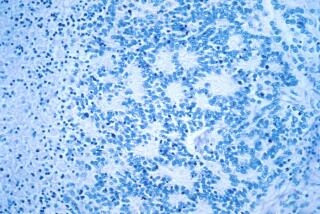MEDICINE NEUROLOGY : Cell Therapy Shows Promise for Parkinson’s
- Share via
An unexpected and potentially significant new approach to the treatment of Parkinson’s disease has been discovered by researchers at Johns Hopkins University in Baltimore.
Neurologist Mahlon R. DeLong and his colleagues report today in the journal Science that destroying a small number of cells in a particular region of the brain of monkeys produces “dramatic and immediate” improvement in the animals’ conditions. Monkeys that had been induced with Parkinson’s symptoms of uncontrollable tremors stopped shaking and were able to use their limbs within one minute after the treatment.
The researchers’ discovery is based on a line of evidence suggesting that cells in the region, called the subthalamic nucleus, become overexcited in victims of Parkinson’s, producing the tremors and rigidity that are characteristic of the disease.
Their research in monkeys suggests that it might be possible to make dramatic improvements in the conditions of human patients either by destroying the cells in a rather simple operation or by developing new drugs that would inhibit those cells without affecting others in the brain.
Although DeLong has already had many patients volunteer for the surgery, he said: “I would not want to encourage patients or surgeons that this is the thing to do now. It is simply too early to take that jump.”
But neurologist Donald Calne of the University of British Columbia in Vancouver, Canada, said that “given the current state of knowledge, there would be every justification for a very careful, limited clinical study of (the technique in humans) based on Dr. DeLong’s findings.”
Parkinson’s disease results from the death of brain cells that produce the neurotransmitter dopamine, a brain hormone that is particularly important in the control of muscle movement. Symptoms can be alleviated in the early stages of the disease with the drug L-dopa, which is converted into dopamine in the brain.
Recently, neurosurgeons have been experimenting with transplants of dopamine-producing cells into the brain in an effort to cure the disease. Transplants of cells from the adrenal glands have given mixed results, but transplants of brain cells from aborted fetuses have shown great promise. Those transplants have been impeded, however, by the intense debate over the use of tissues from fetuses in medical research and therapy.
DeLong’s approach, if it can be shown effective in a larger number of animal experiments, may provide a way to eliminate the controversial use of fetal cells.
His work is based on studies that show that when the brain becomes depleted of dopamine, cells in the subthalamic nucleus region of the brain become much more active, firing their neurons repeatedly. DeLong hypothesized that this excessive activity causes the tremors associated with Parkinson’s.
To test this hypothesis, he injected three monkeys with a chemical, called MPTP, that kills dopamine-secreting cells, thus producing a Parkinson’s-like condition. Such animals are widely used in studies of potential Parkinson’s therapies.
He then injected the subthalamic nucleus with another chemical, called ibotenic acid, that would kill only the overexcited cells.
The results were dramatic: Within one minute after the injections, the tremors died out and the monkeys began using their arms in a purposeful manner. Although the animals retained some residual clumsiness, they were once again able to feed and groom themselves, said DeLong, who is now at Emory University in Atlanta.





